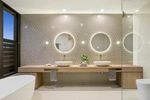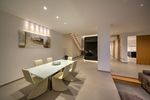Creative Lighting Guide - Lighting Council Australia
←
→
Page content transcription
If your browser does not render page correctly, please read the page content below
Introduction
Impressive lighting enhances the beauty of buildings and maximises value. It is also functional,
productive, sustainable, relaxing, interesting, and welcoming.
Lighting should be an early and considered part of a complete home or building design. Talk with
your lighting supplier and electrician about your ideas.
Those seeking highly refined lighting designs should contact a professional lighting designer.
The human response to light
Light is known to have visual, emotional, and biological effects on humans. The arrangement of
lighting is important to the use of a particular space and the mood to be created.
Lighting designer Richard Kelly took lighting design to new heights in the 1950s and his concepts are
still valid today. Kelly’s three tenets of lighting design are as follows:
“Focal glow” highlights important elements. It draws attention and separates the important
from the unimportant by using more light in important areas.
“Ambient luminescence” is light that “produces shadowless illumination”. It is not possible to
tell the source of light and no areas appear brighter or darker than others.
“Play of brilliants” is described by Kelly as “Times Square at night, crystal chandeliers and
candlelight in a ball room, sunlight on a fountain, a cache of diamonds in a cave. Play of
brilliants excites the optic nerves, awakens curiosity, sharpens the wit, and stimulates the
body and spirit.”
Kelly used a combination of these three kinds of light to great effect.
Creative lighting considerations
The first step in effective lighting design is to consider:
• How the different spaces will be used? E.g. Relaxation, movement, task areas, etc.
• What features are to be highlighted? E.g. Architectural, art, landscape, etc.
• The paths through and around the home or building that people will take.
Architectural and decorative lighting
• Architectural and decorative lighting creates a mood and adds interest by highlighting art
objects or architectural features using light - e.g., grazing light across textured walls.
• Use spotlights, pendant lighting, chandeliers and wall mounted fittings for their decorative/
architectural effect.
• The light fittings themselves can be the artistic piece on display. Higher ceiling heights or
stairwells are needed for pendant fittings.
• Highlight points of interest and beauty. Objects and areas that are important should receive
more light compared with unimportant areas.Relaxing and interesting lighting
• Non-uniform lighting and lower lighting levels encourage relaxation and creates interest.
More rational and agreeable decisions are made in lower light levels.
• Light and shade are equally important. However, avoid very high brightness/darkness
contrast – balance is needed.
• Use dimmable fittings/lamps and dimmers to reduce light levels and balance lighting
elements.
• Consider some use of narrower beam angle fittings (rather than wide beam angle fittings) to
provide areas of light and shade. Such fittings can have the added benefit of reducing glare.
• Use indirect lighting to reduce glare and shadowing. Indirect lighting bounces light off walls
and ceilings. E.g. LED strip lighting in ceiling coves, under cupboards, behind mirrors etc. Up-
lighting and wall wash lighting are other examples of indirect lighting.
Task and Functional lighting
Task areas such as bathrooms, mirrors, kitchen benches, work desks, reading zones, hobby areas,
dining tables, storerooms, cupboards, wardrobes, etc. should have specific task lighting. Consider
the surfaces to be lit and placement of fittings to avoid shadowing work areas.
Relatively high levels of task lighting at workstations increases alertness and productivity. Low glare,
lower illuminance level lighting outside work surfaces will save energy and increase the perception
that task areas are brightly lit.
Lighting for movement:
Brighter areas have an attractive effect. Use light to guide people into, through and around
buildings.
Light stairs, ramps, doorways, paths and corridors for guidance and safety. Avoid hard shadows at
hazard points. Use light to catch attention. 20 lux is regarded as the minimum illuminance level for
safe movement. Higher levels will be required for ageing eyes.
Australian standard recommended light levels
AS/NZS 1680.1 Interior Lighting includes recommended lighting levels for various tasks.
Area Recommended Illuminance Level (lux)
Corridors, walkways, hallways 40
Lounge room, bed rooms, garages 160
Kitchen bench, dining tables 240
Work desks, reading areas 320 – 400
Hobby areas 600+
Light meter phone apps can provide a basic understanding of lighting levels. However, they are not
calibrated or quality controlled for accuracy.
Comfort and energy considerations
Separately switch or dim individual or small groups of lights to provide comfort and control.
Quality LED fittings and lamps are widely available and use lower amounts of energy compared to
traditional light sources.Examples
The examples below show layers of different lighting that can be used to create relaxation, function,
interest, attraction, and appeal. These are effective ways to increase the visual and emotional appeal
of lit spaces.
Downlight and pendant fixtures
provide general and task
illumination.
LED strip lighting is used to
accentuate architectural features
and increase visual interest.
Image courtesy of Pierlite
Fixtures rated for use outdoors are
resistant to water and dust. Here
they are used to ‘up-light’
landscape features (textured
surfaces), beautify the pool and
assist with wayfinding at night.
Image courtesy of Zumtobel Lighting
A linear lighting fixture provides task
illumination over the dining table.
Up lighting around the permitter of
the room is used to graze/wash the
walls with light to highlight the wall
texture and fill the room with gentle
diffuse light.
Image courtesy of LOWA lightingImage featuring linear up/down
pendant lighting.
The up component uses RGB for
colour tuning – Red in this case to
reflect the store branding.
Image courtesy of LOWA lighting
This bathroom uses down lights to
provide general and task
illumination, diffuse wall lights to
light faces while using the mirrors
and LED strip behind the mirrors to
create visual interest.
Image courtesy of Azoogi Lighting
Image courtesy of Azoogi lighting
-
Image courtesy of Azoogi lighting
Apartment lighting featuring:
• Exterior up/down wall
lighting.
• Downlights
• LED strip lighting
• Sculpture backlight
• RGB pool lighting (blue
shown)
Image courtesy of Azoogi Lighting
Spot lighting provides specific
illumination over the dining table.
Narrow beam downlights draw
attention to the artwork and LED
strip lighting is used to increase
visual interest.
Image courtesy of Zumtobel LightingA variety of lighting creates a relaxed
atmosphere in this bedroom.
Spot lighting draws attention to
artwork. Portable, bed-side lamps
provide diffused general lighting and
LED strip lighting beneath the bed
creates mood and interest.
Image courtesy of Pierlite
Bathroom image featuring:
• ‘IP’ rated downlights in wet
areas.
• Narrow beam downlights
• LED strip lighting
Image courtesy of Zumtobel Lighting
Safety Standards and Regulations
Lighting equipment must comply with Australian regulations and standards. However, no checks are
conducted at the border and non-compliant lights are regularly found in the Australian market.
Low quality and non-compliant LEDs may be unsafe, cause TV and radio interference, not provide
sufficient light, flicker, change colour over time, fail prematurely, or not fit into an existing fitting.
Consumers are advised to purchase products from reputable companies, authorised distributors,
authorised professional suppliers, and registered professionals.
Most lighting products are required to be marked with the regulatory compliance mark.
Lighting Council Australia
Lighting Council Australia is the peak body for Australia’s lighting industry. Our goal is to encourage
the use of quality, environmentally appropriate, energy efficient lighting systems.
Lighting Council Australia members agree to abide by a Code of Conduct and supply products that
comply with Australian standards and regulations. Lighting Council Australia Members are reputable
manufacturers and suppliers whose claims are based on rigorous testing and are reliable.
To access the full list of Lighting Council Australia Members and view the range of lighting brands
please visit: www.lightingcouncil.com.au/member_list/You can also read



























































